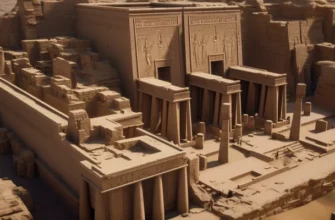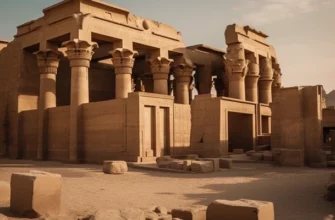The Pyramid of Sneferu at Medum, also known as the Pyramid of Medum, was built by Pharaoh Sneferu sometime in the 26th century BC. This pyramid was one of the first to be built in ancient Egypt, and it was of great importance in the development of pyramid architecture.
Initially, the pyramid was built as a step pyramid consisting of seven steps. However, due to technical problems during construction, while attempting to increase the height of the pyramid, the upper layer collapsed. Construction was then suspended, and the pyramid was left with four steps.
In this regard, the construction of the pyramid was moved to another location, where a small pyramid had already been built. On its basis, a new pyramid was built, which had smooth walls and a steeper slope. This pyramid was about 92 meters high and became the largest pyramid in the world until the construction of the Pyramid of Cheops.
Regarding the methods used to build the Pyramid of Sneferu, scientists suggest that techniques developed during the construction of the step pyramid were used. For example, sleds pulled by people or large animals such as elephants were used to transport large blocks of stone. It is also believed that inclined tracks and a system of blocks and winches were used to lift stones to great heights.
In general, the pyramid of Sneferu in Medum is considered an outstanding example of pyramid construction techniques in Ancient Egypt. In addition, the construction of this pyramid contributed to the development of new technologies and tools that were later used in the construction of other large structures in Egypt.
The pyramid of Sneferu in Meudum is square in shape with a side length of about 144 meters and consists of three stone chambers. The central chamber was about 28 meters high and was intended for the burial of Pharaoh Sneferu. Additional structures, such as temples and small pyramids, were built around the pyramid to bury members of the pharaoh’s family.
Although the pyramid of Sneferu in Meham is not as large as the more famous pyramids, such as the Pyramid of Cheops, it is still an important milestone in the development of pyramid architecture in Egypt. Its construction showed that Egyptian builders not only had knowledge of construction techniques, but also the ability to solve technical problems and adapt to new situations.
- Pharaoh Sneferu’s first major project
- The construction of the pyramid at Meidum and its significance
- The architecture of the pyramid of Sneferu in Medum
- Unusual shape and size
- Stone blocks and their processing
- Engineering solutions of the pyramid of Sneferu in Meidum
- Research and restoration of the pyramid of Sneferu in Meidum
- Conclusions
Pharaoh Sneferu’s first major project
Pharaoh Sneferu’s first major project was the pyramid at Medum, which we discussed earlier. However, he also made significant contributions to the construction of other large structures in Egypt.
For example, Sneferu increased the size and improved the quality of the pyramids built by his predecessors by expanding and improving construction techniques. He changed the shape of the pyramid, making it less steep, which reduced the amount of stone needed for construction and increased the speed of construction.
In addition, Sneferu increased the size and importance of his residence in Dahshur, which he began building in 2575 BC. This residence became an example of the luxury and grandeur of the pharaonic court and also showed that Sneferu was capable of undertaking large construction projects that were not limited to pyramids.
All of Sneferu’s projects were very important for the development of Egyptian architecture and construction technology. His successes increased the prestige of the pharaonic power and allowed Egypt to increase its influence in the East.
The construction of the pyramid at Meidum and its significance
The construction of the pyramid at Meidum was one of the most important projects of Pharaoh Sneferu, who ruled the Egyptian state around 2600 BC. This pyramid is considered one of the first “true” pyramids in Egypt, and it was of great importance for the development of architecture and construction technology in Egypt.
The pyramid at Meudum was originally built as a step pyramid, i.e., a pyramid with several platforms that gradually decrease in size, which makes it very unusual. However, during construction, Sneferu and his engineers realized that this design was unstable, and they changed it to a more traditional pyramid with a single smooth wall.
A large amount of stone, approximately 5 million tons, was used to build the pyramid at Meidum, which testifies to the enormous effort that went into this project. In addition, the pyramid was faced with white limestone, which added to its grandeur and beauty.
Thanks to the pyramid at Meudum, Pharaoh Sneferu demonstrated his ability to carry out large construction projects and develop construction technology, which was an important factor in strengthening his power and prestige. In addition, the pyramid at Medum became an example of the high culture and religious beliefs of the Egyptians, who saw the pyramids as a symbol of unity with the gods and a way to restore life after death.
The architecture of the pyramid of Sneferu in Medum
The pyramid of Sneferu in Medum is considered one of the most important structures in Egypt, as it was the first to be built on the right bank of the Nile and marked a new stage in the development of Egyptian architecture.
The original plan for the pyramid of Sneferu was a multi-step form, which had already been used for the construction of the small pyramid of Pharaoh Khuni in Meidum. However, during construction, engineers changed the plan and transformed the pyramid into a more traditional shape consisting of a single smooth wall rising to a height of 92 meters.
The pyramid was built from stone blocks cut from quarries in the rocky mountains west of the Nile. An important element of the pyramid’s architecture was its internal structure. Inside the pyramid, there were many stone corridors that intersected with each other, as well as rooms that were used to bury the pharaoh and his riches.
One of the most distinctive features of the pyramid at Meidum was its white limestone cladding, which became standard practice for almost all subsequent pyramids in Egypt. This cladding gave the pyramid a smoother and more even appearance and served to protect it from the elements.
In summary, the architecture of the pyramid of Sneferu in Meidum reflected the high level of development of construction and design technologies in Egypt at the beginning of the Old Kingdom.
Unusual shape and size
The pyramid of Sneferu in Meidum is one of the most unusual pyramids of Ancient Egypt. It is also known as the “Transitional Pyramid” because its shape differs from previous pyramids and is transitional between the older form and the later, classical form.
The Pyramid of Sneferu in Meidum has five levels, of which the first three were built of stone and the last two of clay. It measures approximately 101 meters wide and 92 meters long, with a height of about 92 meters. This makes it one of the largest pyramids of Ancient Egypt in terms of volume.
One of the most unusual features of the Pyramid of Sneferu at Meudum is its shape. Unlike most other pyramids, which have smooth, stable sides, the transitional pyramid has walls that rise at an angle of about 60 degrees to the middle of the wall and then slope at an angle of about 45 degrees to the top. This gives the pyramid the appearance of a staircase with open steps, giving it an unusual look.
Another unusual feature of the pyramid of Sneferu at Meidum is its internal structure. It contains two separate pyramids inside – one was intended for the pharaoh and the other for his wife. This structure also differs from the traditional form of pyramids, where the interior usually consists of a single central chamber.
Stone blocks and their processing
Large stone blocks of local limestone and granite were used to build the pyramid of Sneferu in Medum. The stones were quarried near the pyramid and transported to the construction site using large wooden and stone sleds.
Each block was processed so that it could be precisely fitted into its place in the pyramid wall. The processing included cutting smooth, even surfaces and carving grooves to fasten the stones together. These processes required great precision and skill on the part of the craftsmen who worked on the stones.
One of the most impressive technical achievements of the Pyramid of Sneferu at Meidum is the way its walls were constructed. Instead of lifting the blocks to height using ladders or scaffolding, the builders used a system of inclined planes that allowed the blocks to be lifted to the height at which they were to be installed. This technique greatly simplified the construction process and reduced the risk of the walls collapsing during construction.
Overall, the construction of the pyramid of Sneferu in Medum was a huge technical achievement that required a great deal of labor and skill on the part of the craftsmen. It was the first step in the creation of the classic Egyptian pyramids, which became a prominent symbol of Ancient Egypt.
Engineering solutions of the pyramid of Sneferu in Meidum
The pyramid of Sneferu in Meidum was built around 2600 BC and is one of the first large pyramids built in Egypt. Its engineering solutions still impress researchers today.
One of the engineering solutions was the use of a system of inclined planes to lift heavy stone blocks to a height to create the walls of the pyramid. The builders used the slope of the ground to reduce the angle of inclination and the difficulty of lifting the blocks to a great height. It is important to note that this method was very innovative and revolutionary for pyramid construction in Egypt.
Another important engineering solution was the cutting of grooves in the stone blocks, which allowed them to be precisely fitted into the walls of the pyramid. The channels served to fasten the stones to each other and also to drain water from the pyramid when necessary.
A special stone processing technology was also used to create flat surfaces and precise shapes for the pyramid walls. To do this, craftsmen used a harrow, chisel, and other tools to level and remove irregularities on the surfaces of the stone blocks.
Other engineering solutions used in the construction of the Pyramid of Sneferu include the use of a ruler and string to ensure the accuracy and uniformity of the blocks’ dimensions, as well as the use of complex fastening systems and calculations to ensure the stability and strength of the pyramid.
In addition, various materials were used in the construction of the Pyramid of Sneferu, including granite, sandstone, and calcite, each of which had its own characteristics and required different processing methods.
To drain water and prevent flooding of the pyramid, a special system of channels and drains was used to carry water from the base of the pyramid towards the oasis.
Overall, the construction of the pyramid of Sneferu in Meidum was a high-tech project that required a great deal of knowledge and skill in construction technology and engineering. Without a doubt, these engineering solutions were a great achievement for their time and gave impetus to the further development of construction in Egypt.
Research and restoration of the pyramid of Sneferu in Meidum
The pyramid of Sneferu in Meidum was studied in ancient times, in particular, it was described by the Greek historian Herodotus. However, systematic research of the pyramid began only in the 19th-20th centuries, when the era of archaeological excavations began in Egypt.
In 1881, the pyramid of Sneferu was visited by archaeologist and Egyptologist William Flinders Petrie, who took several measurements and photographs. In the 1920s, the pyramid was explored by an expedition led by archaeologist Sir Flinders Petrie, son of William Petrie. They took more detailed photographs and maps of the pyramid and collected a number of artifacts from the structure and its base.
In the second half of the 20th century, the pyramid of Sneferu underwent restoration work. In the 1950s, the Egyptian government carried out restoration work to preserve the pyramid. Some of the broken stones and statues at the entrance to the pyramid were restored. In the 1980s, restoration work was carried out to preserve the outer shell of the pyramid and repair damage caused by excessive visitor traffic.
Today, the pyramid of Sneferu in Medum continues to attract the attention of archaeologists and tourists. It is one of the most important monuments of Egyptian architecture and engineering, which
testifies to the greatness and technological achievements of ancient Egypt. In 2021, plans were announced for new research and restoration work on the pyramid of Sneferu in Meidum. In particular, there are plans to scan the pyramid using modern technology to study its structure and components in more detail.
There are also plans to carry out restoration work to preserve and repair damaged areas of the pyramid. For example, some of the pyramid’s steps have lost their shape and need to be restored. There are also plans to reinforce the pyramid’s foundation and strengthen the outer shell of the structure.
The research and restoration of the Pyramid of Sneferu in Medum is important work for preserving this historic structure for future generations. In addition, this work allows us to learn more about the engineering and architectural solutions used in ancient Egypt and their impact on the development of construction technologies in the future.
Conclusions
The pyramid of Sneferu in Meidum is of great importance for studying the history and culture of Ancient Egypt. Its grandeur and complexity testify to the high level of technology that was used at that time for construction. The pyramid also allows us to study the architectural and engineering solutions that were used to create this structure.
The study and preservation of historical monuments is a very important task. It allows us to preserve cultural heritage and the memory of past eras for future generations. In addition, the study of historical monuments provides an opportunity to learn more about the history and culture of past eras and the interrelationships between different peoples and civilizations.
In this context, the study and restoration of the pyramid of Sneferu in Medum is an important task for preserving historical heritage and restoring its original beauty. Such work allows us to learn more about the engineering and architectural achievements of Ancient Egypt and preserve this heritage for future generations.








